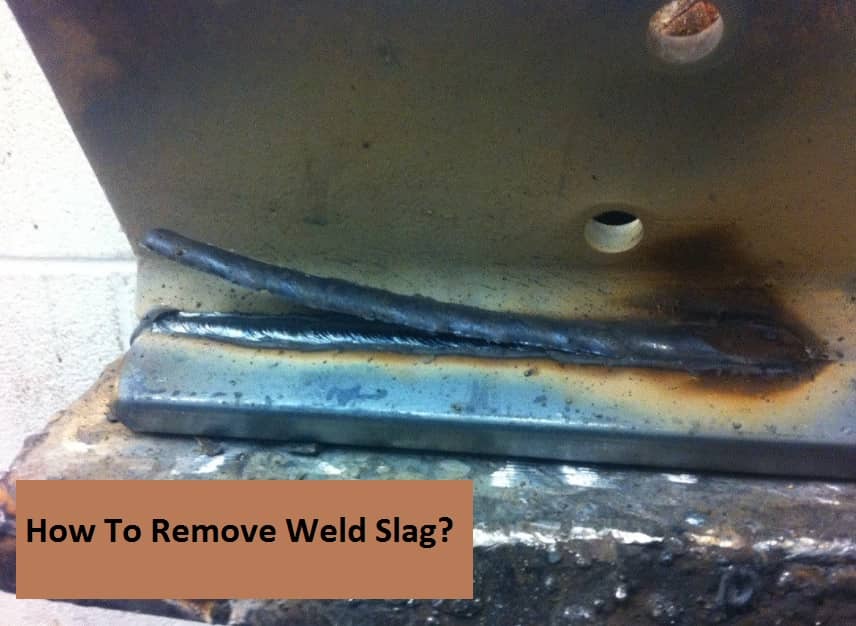You might be wondering how to remove weld slag. Lots of tips and tricks are there. We all know that welding slag is a by-product produced during welding processes. But you can definitely get rid of it.
The most commonly opted solutions include grinding, sanding, chipping, flame cleaning, abrasive blast cleaning, or wire brushing. Remember that removing weld slag involves mechanical processing. You can easily take it off from the respective material by chipping it with hammers or a needle scaler. Below we have elaborated more of the details that tell you precisely how to remove this by-product properly:
What is a weld slag?
Welding slag is a non-metallic by-product that is always developed while you carry out a shielded metal arc welding or flux-cored arc welding process. It has nonmetallic impurities and comes in a vitreous material.
Many welders have found this material quite troublesome and are eagerly looking for ways to get rid of it. Chipping or grinding solutions might help you! Though welders have called it a problematic material, at the same time, slag production ensures good weld quality and positively impacts the wire’s welding characteristics. In addition, it protects the weld from getting oxidized.
Tips to get rid of welding slag
Popular solutions that immediately help you eliminate welding slag include chipping, grinding, sanding, using wire brushes or wheels, or utilizing a needle scaler. You will always find slag or spatter when involved in MIG and arc welding. To tidy up the material, you need specific tools and techniques.
1: Use an anti-spatter spray
The job has become easy to get rid of the welding slag, which is possible by using a good quality anti-spatter spray. Using it, you can remove 95% of the spatter or slag without trouble.
What you need to do is to spray the affected area. After some time, you will see that the large chunk of the slag will bounce away. You can purchase the anti-spatter spray from any reliable local welding shop.
Thus, spraying the workpiece makes it slag-free. You can even spray the MIG nozzle to prevent slag production and restrict gas flow. Just spend a few of the bucks, and hopefully, the problem will get eliminated in one go.
2: Chipping
Chipping with a hammer and chisel seems another effective solution to eliminating welding slag. It is generally believed that slag is not so strongly connected to the base metal. The connection looks weak and does not catch up with good penetration.
That is why chipping the slag might help you remove it in one go. So, chip this by-product with a hammer or chisel and knock off the troublesome material. Many coil spring chipping hammers have been launched. You can choose any of them as they work smartly and remarkably to get the slag off. Furthermore, the handle absorbs the shock of hammering, and it gets easy for you to focus enough blows while knocking off the slag/spatter.
The minute you notice that the slag is not completely removed from the respective area. Then it is recommended to use a cold chisel. It will help you apply more force easily, and every little trace of slag will come off. Chisels lets you make a hit exactly and accurately where you want it. The only drawback of using hammers and chisels is that they tend to leave minor scars on the area where the slag was!
3: Grinding and sanding
How about doing grinding and sanding for eliminating the welding slag? Yes, you can opt for this solution. Varieties of tools are there that let you efficiently grind and sand down the welding areas.
It is suggested to get an angle grinder that comes with a flap disc. Such a grinder seems an ideal pick for removing the slag effortlessly. Besides, an angle grinder lets you access hard-to-reach areas smoothly. In fact, when removing slag from the sheet metal or welding tube, only this kind of grinder should be used.
You can even invest in a power filer, another amazing product to grind and sand down the slag in no time. It helps you reach tight places and remains well worth the money.
Tips to prevent the weld slag
If you notice that the welding slag is excessive, you must choose the settings and techniques wisely to prevent the slag from getting developed on the metal. Moreover, slag will remain there if the setup looks problematic or the technique looks off.
Excessive slag develops when the shielding gas, wire speed, or power looks not so okay. Make sure that you check the following:
Conclusion
So, what’s the bottom line? We have mentioned quite handy and effective tips regarding removing the welding slag. Wrapping up! You can effortlessly and smoothly eliminate excessive slag by chipping it with a hammer and chisel, grinding and sanding, using an anti-spatter spray, a flap disc, and a power filer. Other methods include using a wire brush opting for flame-cleaning and abrasive blast cleaning.
No wonder slag will always develop during shielded metal arc welding, brazing, or flux-cored arc welding. It is marked as a by-product appearing in a vitreous material. But removing it from the metal remains a must for the welder! You can follow the solutions mentioned earlier whenever you spot a minor slag/spatter.
